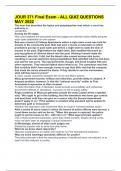21st November
Cost and Management Accounting - Absorption Costing/Activity
Based Costing
Cost and Management Accounting
- Examines costs incurred by the business and assigns costs in a systematic manner
- To inform and advise internal management how to optimise business practices based
on capacity and cost efficiencies (limiting factors: are we running efficiently, what
capital do we have, how large are we, how much staff do we have?)
- Information is relevant to organisation - comparability not required
- Used to forecast and plan, guide and control
- Assist in achieving short and long-term goals
Planning
We all work within budgets, although these may be different
Generally, we have a limited income
We can choose how we spend that income
Businesses exist to make a profit
To increase profit:
- Increase sales (volume or price)
- Decrease expenses (volume or cost)
Expenses consist of:
- Materials
- Labour
- Other expenses, including overheads (things that exist that do not relate to the
actual production)
Direct/Variable/Marginal Costs
DIRECT COSTS: Directly attributable to the product
- Materials
- Labour
- Expenses (e.g. electricity cost of using a machine to make one unit)
If a direct cost varies directly in line with each unit of output produced, it is a variable
cost Marginal cost
Variable Cost Behaviour
Variable costs of production expected to behave in linear fashion; they will rise
precisely in line with the number of units produced
Effects of production on variable costs
Fixed Cost Behaviour
Some costs remain the same, regardless of
production
- Salaries
- Rent of premises
- General overheads
Effect of production on fixed costs
Total Costs: Fixed + Variable
Effect of production on variable, fixed and total costs
, Absorption Costing (Also known as Full Costing)
ABSORPTION COSTING: An allocation of indirect costs is made to each unit of
production on the basis of the expected production level so that indirect costs are
recovered with each unit of production sold
MARGINAL COSTING: Only variable costs are used to calculate the cost of production
Cost of Producing One Unit
Direct Production Costs:
-Direct Materials
-Direct Labour
-Direct Expense
= PRIME COST
Indirect Production Costs (overheads):
-Rent (per unit)
-Rates (per unit)
-Heating etc. (per unit)
= TOTAL INDIRECT COSTS
Total Production Costs for One Unit = PRIME COST + TOTAL INDIRECT COSTS
~PROFIT FOR THE YEAR = Sales – (Prime Costs + Total Indirect Costs)~
Profit Calculation for the Sale of all Units
Sales 1,000 x £85 = 85,000
Direct Costs
Direct Material
• Wood 1,000 x £18 18,000
• Glue 1,000 x £0.60 600
• Screws 1,000 x £1 1,000
• Sandpaper 1,000 x £0.40 400
Direct Labour
• 1,000 x £25 25,000
Direct Expenses 0
PRIME COSTS = (45,000)
Indirect costs
• Rent 1,000 x £6 6,000
• Rates 1,000 x £1 1,000
• Heating 1,000 x £0.80 800
INDIRECT PRODUCTION COSTS = (7,800)
EXPECTED PROFIT FOR THE YEAR = 32,200
Or: (Selling Price for One Unit - Total Production Costs for One Unit) x Number of Units
Sold
Absorption and Inventory Valuation
Inventory on hand at the end of the period is valued
o For retail business, valued by lower of the cost of goods purchased and net
realisable value





